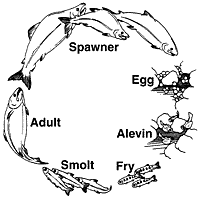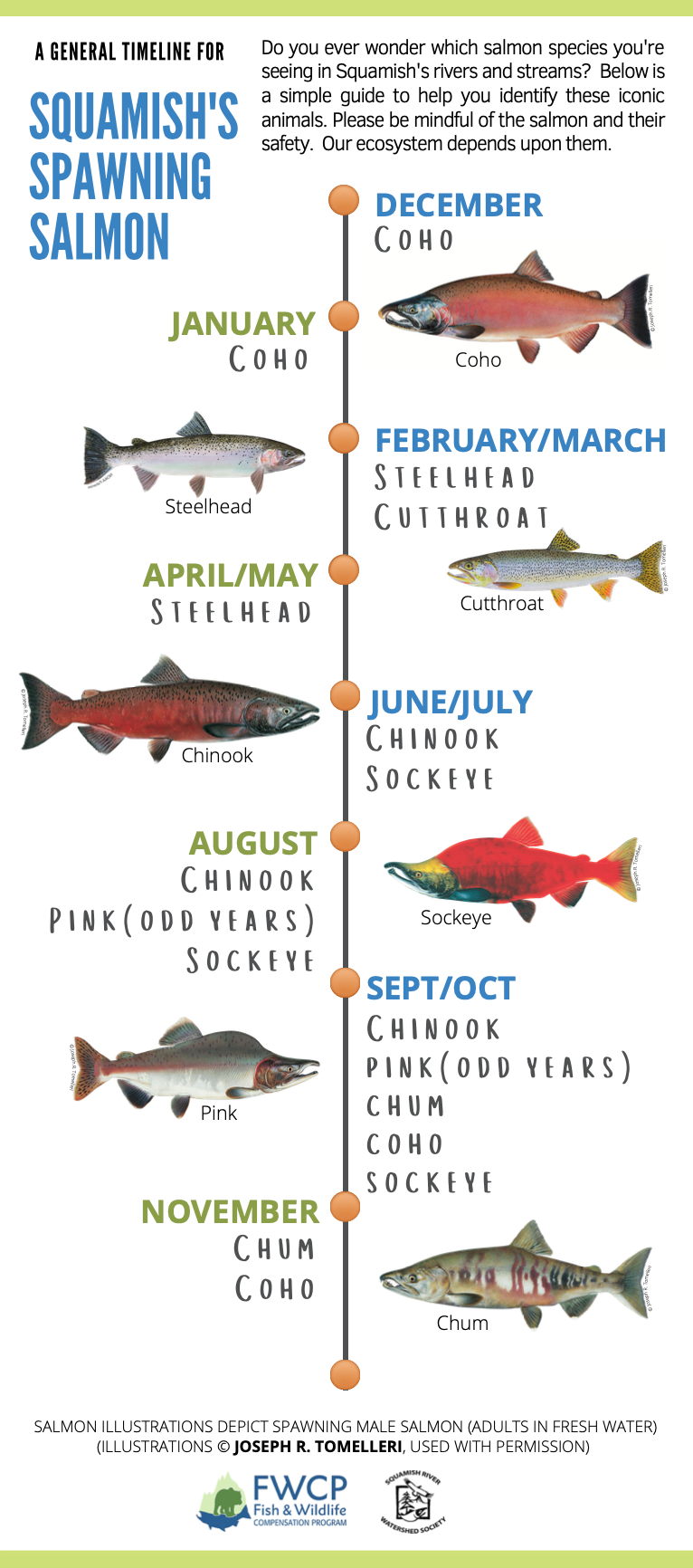A SPECIES THAT FEEDS THE ECOSYSTEM.
Where and When can I see salmon in the Squamish Watershed?
Juvenile Coho salmon can be seen throughout the year, as they tend to stay within the river for 1-3 years before heading to the ocean. However, if you would like to pay a visit to the warriors that have come to spawn in the Squamish watershed, please check out our timeline for adult salmon:
Chinook Salmon (Oncorhynchus tshawytscha)
|
|
Chinook salmon, also known as King, Spring, and Tyee salmon grow to be the largest salmon species on the Pacific Coast. The current record for a fully mature Chinook Salmon is 126 lbs, while the average weight of a mature Chinook is anywhere from 10-50 lbs. Also known for their diverse life span, Chinook salmon spend the first part of their life (0-2 years) in fresh water estuary areas, before heading to sea. They reach sexual maturity anywhere from 2-7years old, and return to spawn in the river system from which they came. Given the large size of these salmon, they require deeper water for spawning. Major river systems in British Columbia, like those found the Squamish River Watershed offers ideal spawning habitat for Chinook. Protected estuaries, like the Squamish River Estuary provides young Chinook smolts with shelter and food to grow. |
Once at sea these fish feed on smaller fish, and serve as a tasty treat to higher tropic level organisms like the killer whale. At sexual maturity, the male Chinooks teeth enlarge and their nose develops into a hook which aids in their competition to fertilize eggs laid in gravel beds. The males also develop a distinct red belly, which signals to their female counterparts that they are ready to spawn.
Howe Sound once supported a Chinook salmon fishery that was shut down in 1968 because stocks were in major decline. Local hatcheries have focused their efforts on rebuilding Chinook populations in recent years, but the species still struggles. Given the diverse life cycle of this King salmon, successful restoration of stocks faces a lot of unknowns. To help answer some of these unknowns, the SRWS, in partnership with Department of Fisheries and Oceans, and the Pacific Salmon Foundation led a 2-year monitoring study examining the out migration of juvenile Chinook in Howe Sound.
Howe Sound once supported a Chinook salmon fishery that was shut down in 1968 because stocks were in major decline. Local hatcheries have focused their efforts on rebuilding Chinook populations in recent years, but the species still struggles. Given the diverse life cycle of this King salmon, successful restoration of stocks faces a lot of unknowns. To help answer some of these unknowns, the SRWS, in partnership with Department of Fisheries and Oceans, and the Pacific Salmon Foundation led a 2-year monitoring study examining the out migration of juvenile Chinook in Howe Sound.
For more information about the following salmonids, please visit Department of Fisheries and Oceans Canada at:
1 (salmon); 2 (cutthroat); 3 (steelhead)
1 (salmon); 2 (cutthroat); 3 (steelhead)
Chum Salmon (Oncorhynchus keta) |
Coho Salmon (Oncorhynchus kisutch) |
Pink Salmon (Oncorhynchus gorbuscha) |
Sockeye Salmon (Oncorhynchus nerka) |
Cutthroat Trout (Oncorhynchus clarkii) |
Steelhead Trout (Oncorhynchus mykiss) |
Tenderfoot Creek Hatchery
Construction of the Tenderfoot Creek Hatchery began in 1981. The facility was built to provide fishing opportunities for First Nations, recreational and commercial fishers. The hatchery focuses on enhancing coho, pink, chum and chinook salmon stocks in the Squamish River watershed.
There are self-guided tours of the site and information signs. Guided tours can be accommodated as operations allow. Please call 604-898-3657 in advance to ask about tour availability and for further information. Check out their website to learn more!
There are self-guided tours of the site and information signs. Guided tours can be accommodated as operations allow. Please call 604-898-3657 in advance to ask about tour availability and for further information. Check out their website to learn more!










